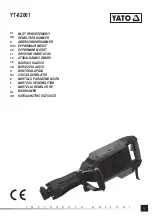
40
G3616/G3617 Mill
Troubleshooting
This section covers the most common problems.
WARNING!
DO NOT make any adjust-
ments until the mill is unplugged and all moving parts have come to a complete stop.
SYMPTOM
POSSIBLE CAUSE
CORRECTIVE ACTION
Machine does not start or
breaker trips.
1. Emergency stop push-button is
engaged, or is faulty.
2. Plug or receptacle is at fault or
wired incorrectly.
3. Start capacitor is faulty.
4. The thermal protection relay below
the motor contactor is tripped.
5. Contactor not getting energized or
has burnt contacts.
6. Wall fuse or circuit breaker is blown
or tripped.
7. Motor connection is wired
incorrectly.
8. Power supply is faulty, or is
switched
OFF
.
9. Electrical box door is open, or door
safety switch is faulty.
10. Motor ON button or ON/OFF switch
is faulty.
11. Centrifugal Switch is at fault.
12. Spindle rotation switch at fault.
13. Cable or wiring is open or has high
resistance.
14. Motor is at fault.
1. Rotate the button knob clockwise slightly until it
pops out, or replace faulty emergency switch.
2. Test power plug and receptacle for good contact
and correct wiring.
3. Test and replace capacitor as required.
4. If no short exists, turn the cut-out dial on the relay
to increase working amps, and push the reset pin,
or replace weak relay.
5. Test for power in and out on all legs, and contactor
operation. Replace unit if faulty.
6. Make sure circuit breaker/fuse is sized correctly for
machine load, or replace weak breaker.
7. Correct motor wiring.
8. Make sure all hot lines and grounds are operational
and have correct voltage on all legs.
9. Close door, or replace faulty limit switch.
10. Replace faulty ON button or ON/OFF switch.
11. Adjust or replace the centrifugal switch if available.
12. Turn switch to FWD or REV, or replace bad switch.
13. Troubleshoot wires for internal or external breaks,
check for disconnected or corroded connections
and repair or replace wiring.
14. Test, repair or replace motor.
Machine stalls or is
underpowered.
1. Wrong workpiece material.
2. Incorrect spindle speed for task.
3. Run capacitor is faulty.
4. Low power supply voltage.
5. Belt(s) is slipping.
6. Motor bearings are at fault.
7. Machine is undersized for the task.
8. Motor has overheated.
9. Centrifugal switch is at fault.
10. Motor is at fault.
1. Only process metal that has the correct properties
for your type of machining.
2. Decrease spindle speed.
3. Test/replace capacitor as required.
4. Make sure all hot lines and grounds are operational
and have correct voltage on all legs.
5. Replace bad belts as a matched set, align pulleys,
and re-tension.
6. Rotate motor shaft for noisy or burnt bearings,
repair/replace as required.
7. Use smaller sharp mill/cutters/drill bits, and reduce
the feed rate, reduce the spindle RPM, and use
cutting fluid if possible.
8. Unobstructed motor cooling air flow, let motor cool,
and reduce workload on machine.
9. Adjust or replace the centrifugal switch if available.
10. Test, repair or replace motor.
Spindle starts, but coolant
pump will not start.
1. Coolant pump relay tripped.
2. Switch at fault.
3. Pump damaged by running without
coolant present.
1. Press the reset button on the coolant pump relay.
2. Replace switch.
3. Replace pump.
Motor/Electrical
Содержание G3616
Страница 2: ......
Страница 20: ...18 G3616 G3617 Mill Hardware Recognition Chart...
Страница 53: ...G3616 G3617 Mill 51 Column Parts Breakdown...
Страница 55: ...G3616 G3617 Mill 53 Rotary Table Parts Breakdown...
Страница 57: ...G3616 G3617 Mill 55 Head Parts Breakdown...
Страница 59: ...G3616 G3617 Mill 57 G3617 Horizontal Spindle Parts Breakdown...
Страница 61: ...G3616 G3617 Mill 59 Power Feed Parts Breakdown...
Страница 64: ...62 G3616 G3617 Mill G3616 Electrical Parts Breakdown...
Страница 66: ...64 G3616 G3617 Mill G3617 Electrical Parts Breakdown...
Страница 68: ...66 G3616 G3617 Mill...
Страница 72: ......
















































